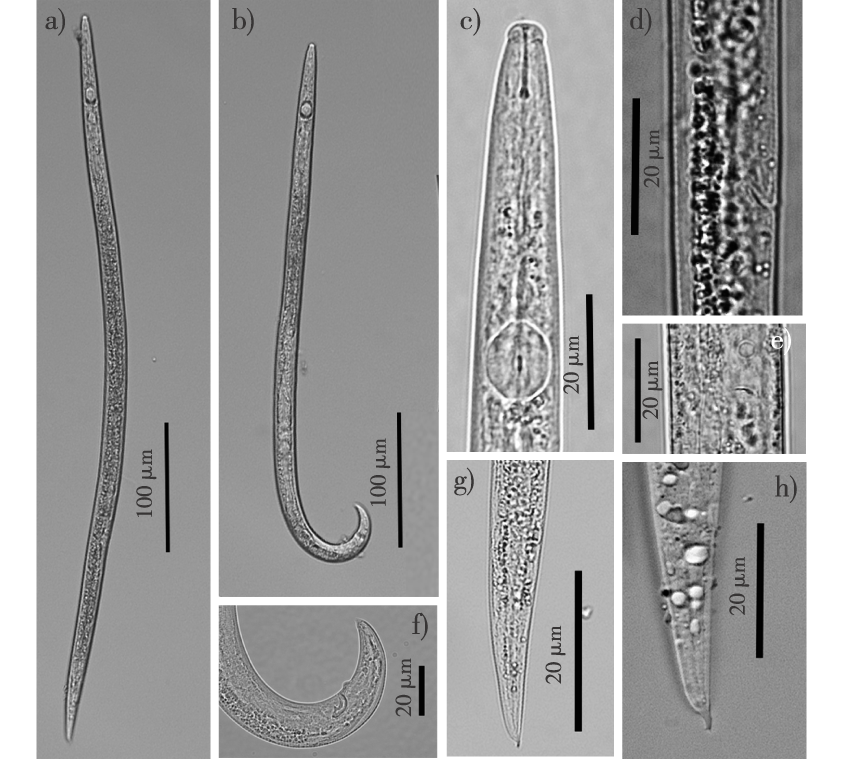 PDF(1807 KB)
PDF(1807 KB)


滑刃属线虫一中国新记录种Aphelenchoides paradanlianensis
王立超, 陈凤毛, 董晓燕, 盛若成, 李欢, 王梦瑶
南京林业大学学报(自然科学版) ›› 2025, Vol. 49 ›› Issue (2) : 169-174.
 PDF(1807 KB)
PDF(1807 KB)
 PDF(1807 KB)
PDF(1807 KB)
滑刃属线虫一中国新记录种Aphelenchoides paradanlianensis
Identification of a newly recorded species of Aphelenchoides paradanlianensis in China
【目的】松树寄生线虫是一类在松树体内取食植物细胞,危害松树健康的无脊椎动物,部分线虫可以导致松树死亡。2022年,从辽宁省黑松中分离出1种寄生线虫,暂将其命名为“Liaoning nematode”,为研究该线虫分类地位,通过形态学和分子生物学鉴定技术,确定其种类并为其防控提供参考。【方法】采用贝尔曼漏斗法对枯死样木进行线虫分离,使用无菌水冲洗线虫3次,将线虫转接到灰葡萄孢(Botrytis cinerea)培养基上培养7 d。使用光学显微镜观察和测计线虫雌雄成虫形态指标以进行形态学鉴定,使用18S rDNA、28S rDNA和COI引物对线虫DNA进行扩增和测序,构建进化树进一步确定线虫的分类地位。【结果】试验分离得到的Liaoning nematode主要形态学鉴定结果如下:雌成虫平均体长为580.6 μm,平均体宽117.3 μm,热杀死后虫体向腹部弯曲,唇区与体部缢缩明显,口针细,具有基部球,中食道球卵圆形,中食道球高和宽分别为11.8 μm和8.4 μm,阴门位于虫体60%~70%处,无阴门盖,呈45°倾斜,后阴子宫囊长度25.6 μm,阴肛距平均为131.9 μm,尾长为33.1 μm,尾端具有蜗牛触角状分叉的尾尖突。雄成虫体前部与雌成虫相似,线虫热杀死后呈“J”形,体长比雌成虫短,平均体长为479.2 μm,体宽为19.0 μm,比雌成虫体宽大,口针长度平均为10.1 μm,交合刺长为14.8 μm,基顶和喙突发达,喙突位于交合刺杆状体的中上部,尾长平均28.0 μm,尾部具有短小的尾突。上述雌成虫与雄成虫的形态特征与Aphelenchoides paradanlianensis相似。使用18S rDNA、28S rDNA和COI引物对线虫DNA进行克隆并测序,分别获得3个基因的目标片段为 914、769和687 bp,将3个基因序列放在 NCBI 上进行 BLAST 比对,结果表明3个基因序列与韩国的A. paradanlianensis基因序列相似度最高。基于18S rDNA、28S rDNA和COI基因引物构建的系统发育树结果表明Liaoning nematode 与 A. paradanlianensis 均聚在1个分支上,进一步确定Liaoning nematode的分类地位。【结论】结合形态学与分子生物学特征,确定从黑松分离的线虫为A. paradanlianensis,为我国松树上首次发现的新记录种。形态学测计中,中国种群体长数值略大于韩国线虫种群体长,但形态特征基本一致,这可能由不同地理种群间的差异或种内变异造成。
【Objective】Parasitic nematodes are invertebrates that infest pine trees, feeding on plant cells and potentially harming tree health. Some nematodes can even kill pines (Pinus spp.). In 2022, a new parasitic nematode was isolated from black pine (Pinus thunbergii) and tentatively named the Liaoning nematode. To clarify its taxonomic status, both morphological and molecular biological identifications were performed to determine its species and guide its prevention and control.【Method】The Baermann funnel method was employed to separate nematodes from dead wood samples. After three washes with sterile water, the nematodes were transferred to Botrytis cinerea for seven days. Morphological characteristics of female and male adult nematodes were observed and measured using light microscopy. For molecular identification, DNA was amplified and sequenced using 18S rDNA, 28S rDNA, and COI gene primers to construct an evolutionary tree and further assess the taxonomic status.【Result】The primary morphological features of the Liaoning nematode are as follows: The average body length of female adults is 580.6 μm, mean body width is 17.3 μm. Female adults are slightly ventrally curved when heat-relaxed, with fine annules between the lip and body and a stylet with small basal swellings. The median bulb is ovoid, with a height and width of 11.8 and 8.4 μm, respectively. The vulva, without a vulval flap, is inclined at 45° and located between 60%-70% of the body length, with a distance from the posterior vaginal sac of 25.6 μm. The average distance between the vagina and anus is 131.9 μm. The tail measures 33.1 μm in length and has terminal shapes resembling snail feelers. The male nematode’s anterior region is similar to the female’s but forms a “J” shape when heat-relaxed and has a shorter body length, approximately 479.2 μm. The stylet length is 10.1 μm, and the body width is about 19.0 μm wider than that of female adults. The spicule length is 14.8 μm, with well-developed condylus and rostrum positioned in the middle and upper part of the spicules. The tail length is 28.0 μm, with short protrusions at the terminal. These morphological features align with A. paradanlianensis. DNA cloning and sequencing of the 18S rDNA, 28S rDNA, and COI genes produced target fragments of 914, 769 and 687 bp, respectively. BLAST alignment on NCBI revealed the highest similarity to A. paradanlianensis. Phylogenetic analysis indicated that the Liaoning nematode and A. paradanlianensis are closely related, confirming the nematode’s taxonomic status.【Conclusion】 Combining morphological and molecular characteristics, the Liaoning nematode isolated from P. thunbergii has been identified as A. paradanlianensis, marking its first discovery on pine trees in China. While morphological measurements of the Chinese population are slightly higher than those of the Korean population, the characteristics are generally consistent, possibly due to geographic variations or intra-species differences.

松树 / 寄生线虫 / 新记录种 / Aphelenchoides paradanlianensis
pine(Pinus spp.) / parasitic nematodes / new record species / Aphelenchoides paradanlianensis
| [1] |
叶建仁, 吴小芹. 松材线虫病研究进展[J]. 中国森林病虫, 2022, 41(3):1-10.
|
| [2] |
王立超, 苏胜荣, 陈凤毛, 等. 黄山马尾松林天牛及携带线虫种类初步调查[J]. 南京林业大学学报(自然科学版), 2022, 46 (4): 29-35.
|
| [3] |
叶建仁. 松材线虫病在中国的流行现状、防治技术与对策分析[J]. 林业科学, 2019, 55(9): 1-10.
|
| [4] |
于海英, 吴昊, 黄瑞芬, 等. 辽宁抚顺樟子松松材线虫分离与鉴定[J]. 中国森林病虫, 2020, 39(2):6-10.
|
| [5] |
|
| [6] |
董瀛谦, 阎合, 潘佳亮, 等. 我国松材线虫病防控对策[J]. 中国森林病虫, 2022, 41(4):1-8.
|
| [7] |
|
| [8] |
|
| [9] |
|
| [10] |
|
| [11] |
|
| [12] |
宋雅婷, 王立超, 孙守慧, 等. 滑刃属线虫1个中国新记录种[J]. 南京林业大学学报 (自然科学版), 2020, 44(3): 105-110.
|
| [13] |
宋雅婷, 刘仁军, 江奕, 等. 中国辽宁咽滑刃线虫的形态与分子系统学描述[J]. 南京林业大学学报(自然科学版), 2020, 44(4):93-101.
|
| [14] |
姜生伟, 吴昊, 李德斌, 等. 我国东北地区松材线虫灾害特征分析[J]. 中国森林病虫, 2022, 41(4):9-15.
|
| [15] |
国家林业和草原局. 国家林草局 2023 年第 7 号公告[EB/OL]. (2023-02-17) [2023-06-20]. http://www.forestry.gov.cn/c/www/gkzfwj/380005.jhtml.
|
| [16] |
|
| [17] |
|
| [18] |
|
| [19] |
史延梅, 陈凤毛, 叶建仁, 等. 我国松树寄生线虫分类检索[J]. 南京林业大学学报(自然科学版), 2012, 36(1): 137-141.
|
| [20] |
王磊, 叶建仁, 史丽娜. 利用腐生线虫加速替代疫木中松材线虫种群数量研究[J]. 南京林业大学学报(自然科学版), 2022, 46(4): 36-44.
|
| [21] |
国家林业和草原局森林和草原病虫害防治总站, 南京林业大学. 中国松材线虫病的发生规律与防治技术[M]. 北京: 中国林业出版社, 2019.
General Station of Forest and Grassland Pest Control of National Forestry and Grassland Administration, Nanjing Forestry University. The occurrence regulation and control techniques of pine wilt disease in China[M]. Beijing: China Forestry Publishing House, 2019.
|
| [22] |
|
| [23] |
盛若成, 李敏, 陈军, 等. 两株我国南北松材线虫虫株形态指标与致病力比较[J]. 南京林业大学学报(自然科学版), 2019, 43(6): 18-24.
|
/
| 〈 |
|
〉 |